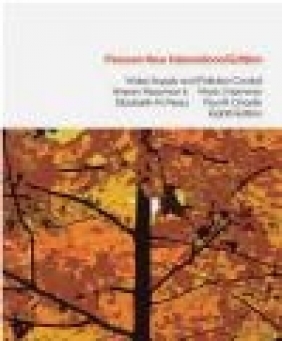Water Supply and Pollution Control
Elizabeth Perez, Mark Hammer, Warren Viessman
Water Supply and Pollution Control
Elizabeth Perez, Mark Hammer, Warren Viessman
- Producent: Pearson
- Rok produkcji: 2013
- ISBN: 9781292026077
- Ilość stron: 752
- Oprawa: Miękka
Niedostępna
Opis: Water Supply and Pollution Control - Elizabeth Perez, Mark Hammer, Warren Viessman
For upper-division undergraduate or beginning graduate courses in civil and environmental engineering. The Eighth Edition of this bestselling text has been revised and modernized to meet the needs of today's environmental engineering students who will be engaged in the design and management of water and wastewater systems. It emphasizes the application of the scientific method to problems associated with the development, movement, and treatment of water and wastewater. Recognizing that all waters are potential sources of supply, the authors present treatment processes in the context of what they can do, rather than dividing them along clean water or waste water lines. An abundance of examples and homework problems amplify the concepts presented.Contents Preface xvii Chapter 1 Introduction 1.1 A Historical Perspective 1.2 A Current Global Issue 1.3 A Look to the Future References Chapter 2 Water Resources Planning and Management 2.1 Environmental Regulation and Protection 2.2 Security of Water Resources Systems 2.3 Watershed Management 2.4 Integrated Watershed Management 2.5 Role of Geographic Information Systems 2.6 Conclusions Problems References Chapter 3 The Hydrologic Cycle and Natural Water Sources 3.1 The Hydrologic Cycle The Water Budget 3.2 Mathematics of Hydrology 3.3 Water Quality 3.4 Soil Moisture Groundwater 3.5 An Introduction to Groundwater Quantity and Quality 3.6 The Subsurface Distribution of Water 3.7 Aquifers 3.8 Safe Yield of an Aquifer 3.9 Groundwater Flow 3.10 Hydraulics of Wells 3.11 Boundary Effects 3.12 Regional Groundwater Systems 3.13 Salt Water Intrusion 3.14 Groundwater Recharge 3.15 Concurrent Development of Groundwater and Surface Water Sources Surface Water 3.16 An Introduction to Surface Water Quantity and Quality 3.17 Surface Water Storage 3.18 Reservoirs 3.19 Losses from Storage 3.20 Impacts of Climate Change on Global Hydrology Problems References Chapter 4 Alternative Sources of Water Supply 4.1 Water Conservation 4.2 Wastewater Reuse 4.3 Stormwater Reuse 4.4 Brackish and Saline Water Conversion 4.5 Interbasin Transfers 4.6 Other Relevant Technologies Problems References Chapter 5 Water Use Trends and Forecasting 5.1 Water-Use Sectors 5.2 Factors Affecting Water Use 5.3 Water Use Trends 5.4 Population 5.5 Long-Term Water Use Forecasting Problems References Chapter 6 Conveying and Distributing Water Hydraulics 6.1 Introduction to Hydraulics 6.2 Uniform Flow 6.3 Gradually Varied Flow and Surface Profiles 6.4 Velocity Water Distribution Systems 6.5 General Design Considerations 6.6 Types of Distribution Systems 6.7 Distribution System Components 6.8 Distribution System Configutations Hydraulic Considerations 6.8 Hydraulic Design Pressure Considerations 6.9 General Design Sequence 6.10 Distribution Reservoirs and Service Storage Pumping 6.11 Pumping Head 6.12 Power 6.13 Cavitation 6.14 System Head 6.15 Pump Characteristics 6.16 Pump Curves Problems References Chapter 7 Wastewater Collection and Stormwater Engineering Design of Sanitary Sewers 7.1 House and Building Connections 7.2 Collection Systems 7.3 Intercepting Sewers 7.4 Materials 7.5 System Layout 7.6 Hydraulic Design 7.7 Protection Against Floodwaters 7.8 Wastewater Pump Stations 7.9 Inflow/Infiltration and Exfiltration Stormwater Management 7.10 Rainfall 7.11 Runoff 7.12 Collection and Conveyance 7.13 Storm Inlets 7.14 Stable Channel Design 7.15 Best Management Practices 7.16 Detention Pond Design 7.17 Retention Pond Design 7.18 Sustainability and Low Impact Development 7.19 Hydrologic and Hydraulic Modeling Problems References Chapter 8 Water Quality Microbiological Quality 8.1 Waterborne Diseases 8.2 Coliform Bacteria as Indicator Organisms 8.3 Monitoring Drinking Water for Pathogens Chemical Quality of Drinking Water 8.4 Assessment of Chemical Quality 8.5 Chemical Contaminants Quality Criteria for Surface Waters 8.6 Water Quality Standards 8.7 Pollution Effects on Aquatic Life 8.8 Conventional Water Pollutants 8.9 Toxic Water Pollutants Selected Pollution Parameters 8.10 Total and Suspended Solids 8.11 Biochemical and Chemical Oxygen Demands 8.12 Coliform Bacteria Problems References Chapter 9 Systems for Treating Wastewater and Water Wastewater Treatment Systems 9.1 Purpose of Wastewater Treatment 9.2 Selection of Treatment Processes Water Treatment Systems 9.3 Water Sources 9.4 Selection of Water Treatment Processes 9.5 Types of Water Treatment Systems 9.6 Water-Processing Residuals Chapter 10 Physical Treatment Processes Flow-Measuring Devices 10.1 Measurement of Water Flow 10.2 Measurement of Wastewater Flow Screening Devices 10.3 Water-Intake Screens 10.4 Screens in Wastewater Treatment 10.5 Shredding Devices Mixing and Flocculation 10.6 Rapid Mixing 10.7 Flocculation Sedimentation 10.8 Fundamentals of Sedimentation 10.9 Types of Clarifiers 10.10 Sedimentation in Water Treatment 10.11 Sedimentation in Wastewater Treatment 10.12 Grit Chambers in Wastewater Treatment Filtration 10.13 Gravity Granular-Media Filtration 10.14 Description of a Typical Gravity Filter System 10.15 Flow Control Through Gravity Filters 10.16 Head Losses Through Filter Media 10.17 Backwashing and Media Fluidization 10.18 Pressure Filters 10.19 Membrane Filtration Problems References Chapter 11 Chemical Treatment Processes Chemical Considerations 11.1 Inorganic Chemicals and Compounds 11.2 Chemical Equilibria 11.3 Hydrogen Ion Concentration 11.4 Alkalinity and pH Relationships 11.5 Ways of Shifting Chemical Equilibria 11.6 Chemical Kinetics Reactions in Continuous-Flow Systems - Real and Ideal Reactors 11.7 Mass Balance Analysis 11.8 Residence Time Distribution 11.9 Ideal Reactors 11.10 Real Reactors Coagulation 11.11 Colloidal Dispersions 11.12 Natural Organic Matter 11.13 Coagulation Process 11.14 Coagulants Water Softening 11.15 Chemistry of Lime-Soda Ash Process 11.16 Process Variations in Lime-Soda Ash Softening 11.17 Other Methods of Water Softening Iron and Manganese Removal 11.18 Chemistry of Iron and Manganese 11.19 Preventive Treatment 11.20 Iron and Manganese Removal Processes Disinfection and By-Product Formation 11.21 Chlorine and Chloramines 11.22 Chlorine Dioxide 11.23 Ozone 11.24 Ultraviolet Radiation 11.25 Disinfection By-Products 11.26 Control of Disinfection By-Products 11.27 Disinfection/Disinfection By-Products Rule Disinfection of Potable Water 11.28 Concept of the Product 11.29 Surface Water Disinfection 11.30 Groundwater Disinfection Disinfection of Wastewater 11.31 Conventional Effluent Disinfection 11.32 Tertiary Effluent Disinfection Taste and Odor 11.33 Control of Taste and Odor Fluoridation 11.34 Fluoridation Corrosion and Corrosion Control 11.35 Electrochemical Mechanism of Iron Corrosion 11.36 Corrosion of Lead Pipe and Solder 11.37 Corrosion of Sewer Pipes Membrane Processes 11.38 Membrane Filtration 11.39 Reverse Osmosis and Nanofiltration Volatile Organic Chemical Removal 11.40 Design of Air-Stripping Towers Synthetic Organic Chemical Removal 11.41 Activated Carbon Adsorption 11.42 Granular Activated Carbon Systems Reduction of Dissolved Salts 11.43 Distillation of Seawater 11.44 Ion Exchange Problems References Chapter 12 Biological Treatment Processes Biological Considerations 12.1 Bacteria and Fungi 12.2 Algae 12.3 Protozoa and Higher Animals 12.4 Metabolism, Energy, and Synthesis 12.5 Enzyme Kinetics 12.6 Growth Kinetics of Pure Bacterial Cultures 12.7 Biological Growth in Wastewater Treatment 12.8 Factors Affecting Growth 12.9 Population Dynamics Characteristics of Wastewater 12.10 Flow and Strength Variations 12.11 Composition of Wastewater Trickling (Biological) Filters 12.12 Biological Process in Trickling Filtration 12.13 Trickling-Filter Operation and Filter Media Requirements 12.14 Trickling-Filter Secondary Systems 12.15 Efficiency Equations for Stone-Media Trickling Filters 12.16 Efficiency Equations for Plastic-Media Trickling Filters 12.17 Combined Trickling-Filter and Activated-Sludge Processes 12.18 Description of Rotating Biological Contactor Media and Process Activated Sludge 12.19 BOD Loadings and Aeration Periods 12.20 Operation of Activated-Sludge Processes 12.21 Activated-Sludge Treatment Systems 12.22 Kinetics Model of the Activated-Sludge Process 12.23 Laboratory Determination of Kinetic Constants 12.24 Application of the Kinetics Model in Process Design 12.25 Oxygen Transfer and Oxygenation Requirements 12.26 Determination of Oxygen Transfer Coefficients Stabilization Ponds 12.27 Description of a Facultative Pond 12.28 BOD Loadings of Facultative Ponds 12.29 Advantages and Disadvantages of Stabilization Ponds 12.30 Completely Mixed Aerated Lagoons Odor Control 12.31 Sources of Odors in Wastewater Treatment 12.32 Methods of Odor Control Individual On-Site Wastewater Disposal 12.33 Septic Tank-Absorption Field System Marine Wastewater Disposal 12.34 Ocean Outfalls Problems References Chapter 13 Processing of Sludges Sources, Characteristics, and Quantities of Waste Sludges 13.1 Weight and Volume Relationships 13.2 Characteristics and Quantities of Wastewater Sludges 13.3 Characteristics and Quantities of Water-Processing Sludges Arrangement of Unit Processes in Sludge Disposal 13.4 Selection of Processes for Wastewater Sludges 13.5 Selection of Processes for Water Treatment Sludges Gravity Thickening 13.6 Gravity Sludge Thickeners in Wastewater Treatment 13.7 Gravity Sludge Thickeners in Water Treatment Gravity Belt Thickening 13.8 Description of a Gravity Belt Thickener 13.9 Layout of a Gravity Belt Thickener System 13.10 Sizing of Gravity Belt Thickeners Flotation Thickening 13.11 Description of Dissolved-Air Flotation 13.12 Design of Dissolved-Air Flotation Units Biological Sludge Digestion 13.13 Anaerobic Sludge Digestion 13.14 Single-Stage Floating-Cover Digesters 13.15 High-Rate (Completely Mixed) Digesters 13.16 Volatile Solids Loadings and Digester Capacity 13.17 Aerobic Sludge Digestion 13.18 Open-Air Drying Beds 13.19 Composting Pressure Filtration 13.20 Description of Belt Filter Press Dewatering 13.21 Application of Belt Filter Dewatering 13.22 Sizing of Belt Filter Presses 13.23 Description of Filter Press Dewatering 13.24 Application of Pressure Filtration Centrifugation 13.25 Description of Centrifugation 13.26 Applications of Centrifugation Cycling of Waste Solids in Treatment Plants 13.27 Suspended-Solids Removal Efficiency Final Disposal or Use 13.28 Land Application 13.29 Codisposal in a Municipal Solid-Waste Landfill 13.30 Surface Land Disposal Problems References Appendix Index
Producent:
GPSR Pearson Central Europe Sp. z o.o.
ul. Szamocka 8
01-748 Warszawa (PL)
tel: 459 596 060
email: [email protected]
Szczegóły: Water Supply and Pollution Control - Elizabeth Perez, Mark Hammer, Warren Viessman
Tytuł: Water Supply and Pollution Control
Autor: Elizabeth Perez, Mark Hammer, Warren Viessman
Producent: Pearson
ISBN: 9781292026077
Rok produkcji: 2013
Ilość stron: 752
Oprawa: Miękka
Waga: 1.53 kg






























